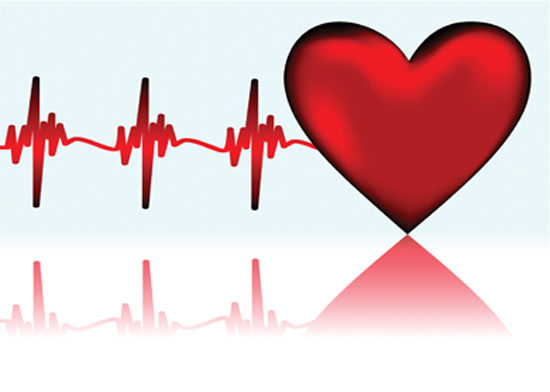There are many paths to the heart: The notion rings true both in love and dietary supplementation. There is a vast and growing block of products claiming to support cardiovascular health, in one fashion or another. The consumer must wade through a steady stream of targeted and often conflicting health claims to suit their given need, and they need all the help they can get from knowledgeable sources. This is where their friendly supplements retailer can step in, to guide them in one of the myriad approaches to a healthier heart through natural means.
In as many ways as cardiovascular health can begin to fail, it can also be corrected, strengthened and made to flourish. This can be accomplished with the many research-backed means to replace what is lacking, strengthen what is weak or to free what has become congested in our circulatory pathways. Doctors, executives and insiders, representing a diverse array of companies in this segment, will inform and comment on the scientific and market talk that’s been circulating these days. Beyond, there is a look at what’s new, what’s enduring and what’s coming in this, perhaps the most central of health support categories.
Cardiovascular Support: All In the Same Vein?
Well-established supplement categories based on solid, decades-old science reside alongside up-and-comers and niche solutions in the heart health market. Heart health pioneers are expanding upon, and sometimes seeking to reverse, old notions about how the cardiovascular system can be supported via supplementation. 
The only idea all parties agree on is that no approach is complete. Indeed, nearly every identifiable aspect of nutrition is part of the interconnected web of structure and function that comprises the cardiovascular system. “The pathological bases for cardiovascular disease (a general term for all disorders of the heart and blood vessels) are likely many,” says Sid Shastri, M.Sc., product development manager for Kaneka Nutrients, Pasadena, TX.
Meanwhile, the need for greater consciousness of cardiovascular health issues is dire. “It is of great importance to address the obesity and overweight issue affecting our country today because it is prevalent and the numbers are continuing to escalate,” says Trisha Sugarek, national educator and R&D specialist for Bluebonnet Nutrition Corporation, Sugar Land, TX. She cites a National Institutes of Health statistic that currently, 97 million U.S. adults are overweight or obese. Individuals that fall into these categories are statistically more susceptible to various forms of cardiovascular disease (CVD).
This state of affairs is borne out by the dollar figures. According to Joseph Evans, Ph.D., manager of pharmacology at Stratum Nutrition, St. Charles, MO, the revenues for the total U.S. heart health ingredient market was around $563 million in 2008. That number is projected to exceed $1 billion by 2012 and $2 billion by 2015. That is a compound annual growth rate, Evans says, of about 21% in that time frame. He supports those skyrocketing stats with even more: “The number of supplement product launches with a cardiovascular health claim in 2008 was about 201, an increase of about 12% from the previous year, and about 430% from 2004.”
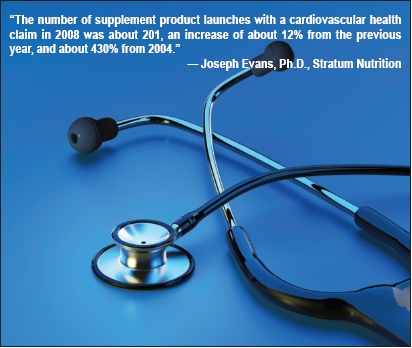 Moving beyond the numbers, it is now time to find out what’s new in the heart health category. There is exciting new research attached to a variety of supplement types, and, as we will soon find out in detail, there are those who foresee sweeping undercurrents of change that will alter our understanding of the health issues at hand.
Moving beyond the numbers, it is now time to find out what’s new in the heart health category. There is exciting new research attached to a variety of supplement types, and, as we will soon find out in detail, there are those who foresee sweeping undercurrents of change that will alter our understanding of the health issues at hand.
New Research: Health Benefits and Support
Vitamin K2, which we will return to later in a regulatory context, is the subject of new studies demonstrating its heart health benefits. “Vitamin K, as we all know, is the last frontier of vitaminology and its benefits to heart health are new, and very exciting,” says Sugarek, while adding that it has a long way to go to catch up with supplements that have U.S. Food and Drug Administration (FDA) recognized health claims, such as omega-3s and B vitamins.
One study on K2 is cited by a team from A.C. Grace Company, Big Sandy, TX, which includes Mark C. Houston, M.D., M.S., Andreas M. Papas, Ph.D., and Lyn Capps, president and CEO. Published in The Journal of Nutrition and based on a sample group of 4,807 subjects, it showed that vitamin K2 (Menaquinone) may be important in preventing coronary heart disease (CHD) (1). Vitamin K2 and other nutrients may have the ability to reduce the progression of coronary atherosclerotic blockages, improve regression of plaques within coronary circulation and reduce stenosis after stent placement and/or following coronary artery bypass, according to other studies cited by the A.C. Grace team.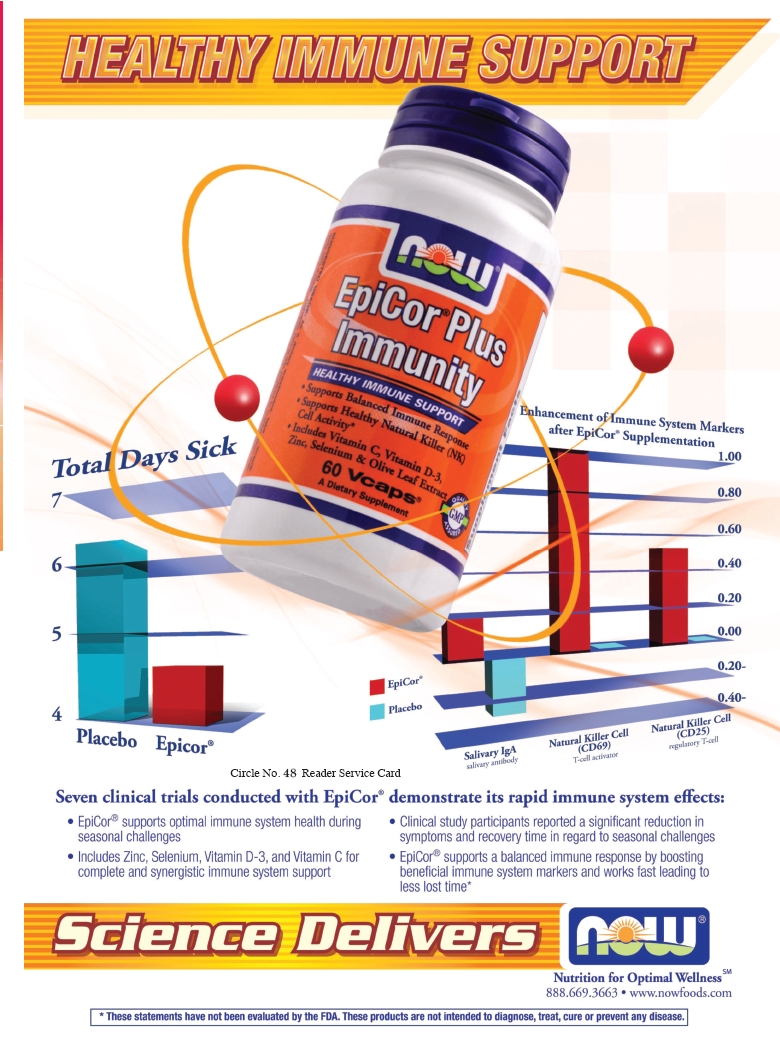
The enzyme nattokinase, extracted from a Japanese fermented soy bean called natto (which also contains vitamin K2), has been the subject of research into its high fibrinolytic activity (the breaking down of fibrin, the blood clotting protein) and antioxidant activity, according to Dave Barton, director of education, Enzymedica, Port Charlotte, FL.
One such study involving nattokinase was conducted on Japanese volunteers. “The tests indicated that nattokinase generated a heightened ability to support circulation. On average, the volunteers’ ELT (Euglobulin lysis time, a measure of how long it takes to dissolve a blood clot) dropped by 48% within two hours of treatment. An additional study showed an 11% decrease in blood pressure after just two weeks,” Barton says (2).
In the rush to supplement with calcium for bone health and other reasons, many consumers neglect its counterpart: magnesium. About four out of five people don’t get their minimum daily requirement of magnesium from diet alone, according to Ken Whitman, president of Peter Gillham’s Natural Vitality, Austin, TX. “The balance of magnesium and calcium is extremely important. In America, most of us, by reason of diet and/or supplementation, have very high calcium levels. Unabsorbed calcium can cause calcification and serious health problems,” he says.
There are numerous published research studies that point to the diverse cardiovascular benefits from magnesium intake (3). From lowering blood pressure to fostering regular heart rhythms, the upside is well-chronicled for this mineral, in which many experts agree individuals are often deficient.
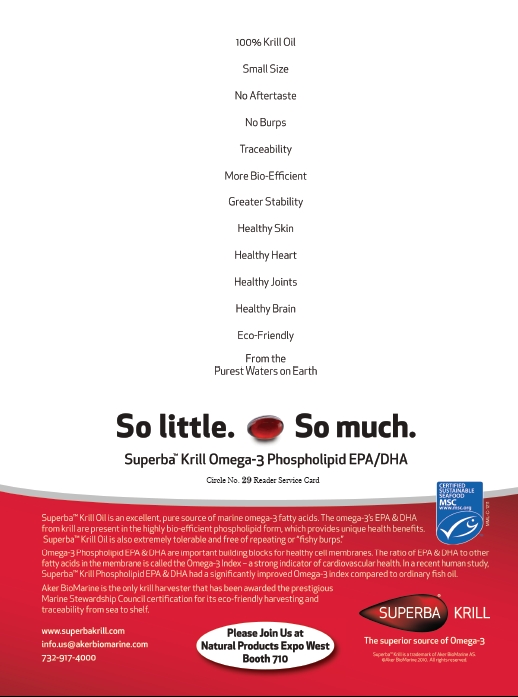 An up-and-coming entry to the heart health supplement market is cocoa, which is being utilized in a supplement designed to provide the known health benefits of dark chocolate without the calories, fat and sugar. “Cocoa has immense potential to come to the forefront of the market,” says Rob Maru, vice president of innovation and brand development for Reserveage Organics, Gainesville, FL, makers of a new cocoa-infused supplement.
An up-and-coming entry to the heart health supplement market is cocoa, which is being utilized in a supplement designed to provide the known health benefits of dark chocolate without the calories, fat and sugar. “Cocoa has immense potential to come to the forefront of the market,” says Rob Maru, vice president of innovation and brand development for Reserveage Organics, Gainesville, FL, makers of a new cocoa-infused supplement.
Maru says that cocoa has been under study recently to determine the possible heart health benefits of the flavonols within the substance. “One of the newest trends is treating heart health by protecting the endothelial function, which incorporates relaxing blood vessels, protecting lining and enhancing nitric oxide production. Cocoa does all of this,” Maru says. Endothelial cells mediate the coagulation of blood through the dilation and constriction of vessels, and their dysfunction is an early marker of atherosclerosis.
The krill oil market segment has recent research to further bolster its health claims, according to Eric Anderson, vice president of sales and marketing, Aker BioMarine Antarctic US, Seattle, WA. One study he cites showed a jump in the bioavailability of omega-3s after krill oil consumption, based on the “omega-3 index,” a measurable risk factor for CHD that is growing in usage. “The omega-3 index is a reliable diagnostic tool that presents the combined EPA and DHA concentration as a percentage of total fatty acids in red blood cells,” Anderson says. 
Participants in the study started out averaging a relatively low omega-3 index of 2.0, and after eight weeks with daily intake of a proprietary krill oil (Superba from Aker BioMarine), the average index increased to 4.5, or 125%, with a 45% increase apparent after only two weeks. Omega-3s such as those found in fish oil are associated with heart health through a litany of research, which demonstrates a reduced risk of heart failure and other related benefits from increasing their intake.
Whole-food and botanical extracts are often sought after for the array of nutrients they can provide in combination. One example is celery seed extract, which Michael T. Murray, N.D., director of product development and education, Natural Factors, Everett, WA, says has heart-supportive effects: “The celery seed extract is concentrated to contain 85% 3-n-butylphthalide—the key component responsible for not only the characteristic odor of celery, but also its benefits in heart health.”
WholeFoods has recently reported on a study that found aged garlic extract is a useful adjunct for conventional hypertension therapy, as it reduced high systolic blood pressure in patients (4). Jay Levy, director of sales, Wakunaga, Mission Viejo, CA, notes recently published clinical studies from UCLA Medical Center, using their proprietary aged garlic extract (Kyolic), showed that the extract slowed the rate of atherosclerotic plaque burden (CAC) compared to placebo in 65 intermediate risk patients. He adds, “Aged garlic extract may also reduce the side effects of prescription drugs when used as an adjunct therapy (aspirin, statins, etc.), while improving the efficacy of the drugs.”
Two ancient mushroom remedies come recommended from Mark J. Kaylor, vice president of education and research, Mushroom Wisdom, East Rutherford, NJ. Reishi and holy basil, he says, are becoming more popular for cardiovascular applications. They are elements of traditional Chinese Medicine, and its principle called Shen (body/mind/spirit “oneness”).
In terms of experienced benefits, they are said to help relieve stress and promote focus, and according to Kaylor these actions are clinically measurable through blood pressure and other tests. One study found that Holy basil (Ocimum sanctum) may positively influence the course of inflammatory disorders (5). Inflammation is an oft-cited factor in heart disease, as will be expanded upon later.
New Frontiers: Emerging Categories, Novel Approaches
Continuous scientific verification is how established categories seek to solidify their positions with consumers, and how new ingredients stake a claim. But creating a whole new approach to supplementation, based on a fresh understanding of the processes underlying health, takes both research and innovative thinking.
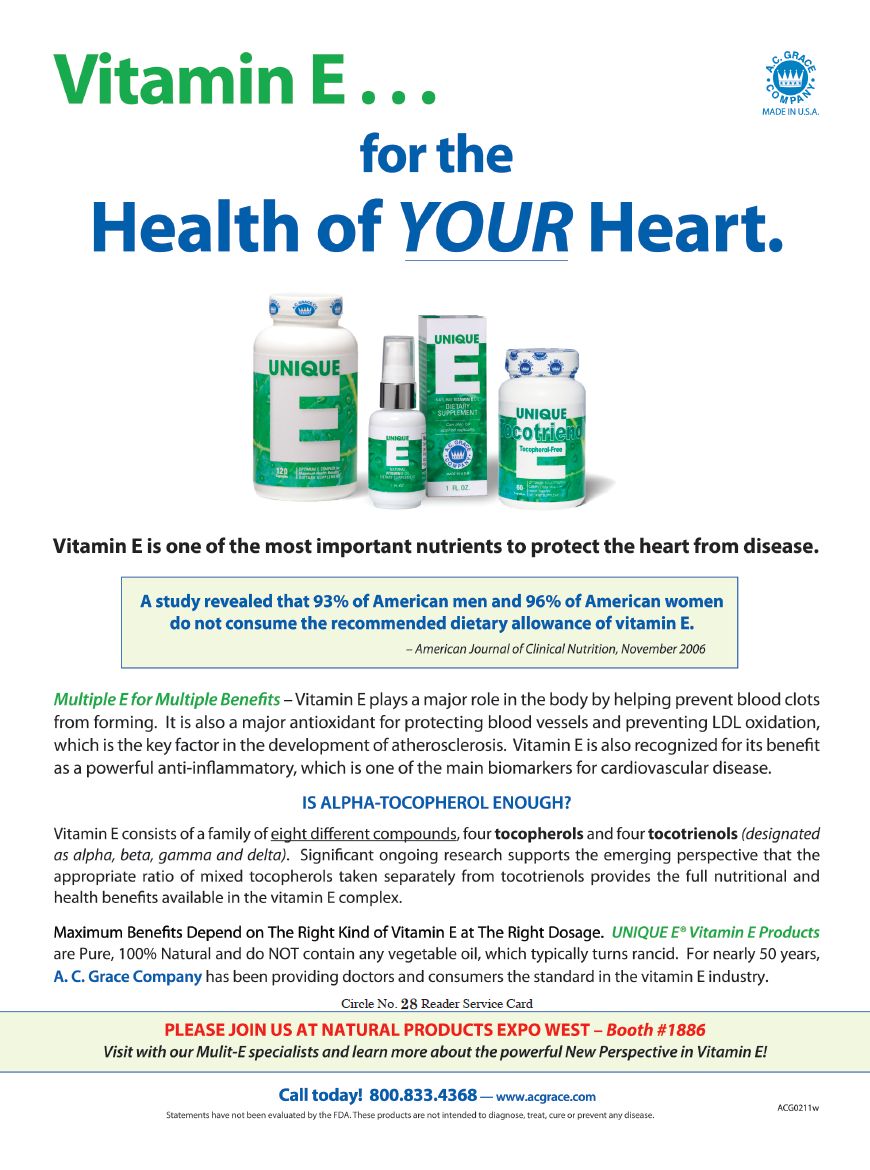 Vitamin E revisited. Case in point is vitamin E, and the shift in understanding that has taken place surrounding this nutrient’s health benefits, according to the A.C. Grace team. The benefits of vitamin E for heart health became widely recognized following clinical trials published in the New England Journal of Medicine, receiving international attention.
Vitamin E revisited. Case in point is vitamin E, and the shift in understanding that has taken place surrounding this nutrient’s health benefits, according to the A.C. Grace team. The benefits of vitamin E for heart health became widely recognized following clinical trials published in the New England Journal of Medicine, receiving international attention.
Subsequently, clinical studies using alpha-tocopherol (one component of vitamin E), such as the Heart Outcomes Prevention Evaluation (HOPE), along with meta-analyses, seemed to disconfirm some of the scientific support for the vitamin’s benefits. This led to the scaling back of industry and medical support for vitamin E in supplement form. “This controversy provided the impetus for significant research, leading to a new understanding of the forms of vitamin E and its role in nutrition and health, including cardiovascular health,” says A.C. Grace.
The result of this new research is a paradigm shift, the company says, the details of which follow: Eight different molecular compounds fall under the heading of vitamin E. Four of these are tocopherols, and four are tocotrienols, designated as alpha, beta, gamma and delta. Food with vitamin E contain all eight compounds in varying balances. Our diets are often richer in alpha-tocopherols, and this compound had become the most common form used for food fortification, supplements and, crucially, in human clinical trials, according to A.C. Grace.
Research, however, has shown that the complete grouping of tocopherols and tocotrienols allows vitamin E to provide the health benefits originally associated with it. This understanding is creating a new perspective, says A.C. Grace, which dictates that the full complement of compounds should be used in supplement formulations and in future research. Some products deliver the vitamin compounds separately for more targeted health benefits, such as a tocotrienol-only supplement, while others, like one from A.C. Grace, provide them all in concert.
For cardiovascular health, specifically, research has shown that gamma-tocopherol is an effective form in combating the nitrogen radicals that precede inflammation and CVD. Collaborative research by the University of North Carolina, Michigan State, Berkeley and Purdue Universities and funded by the National Institutes of Heath showed that the anti-inflammatory properties of gamma-tocopherol reduced systemic oxidative stress and inhibited important inflammatory pathways related to cardiovascular well-being.
Likewise, the tocotrienols, and gamma-tocotrienol in particular, have been shown in recent research to suppress the production of 3-hydroxy-3-methylglutaryl-coenzyme A reductase (HMG-CoA), which is involved in LDL cholesterol formation (6). Additionally, there is evidence, according to A.C. Grace, that high levels of alpha-tocopherol by itself can lead to the depletion in the bloodstream of the other important compounds within vitamin E, inhibiting their unique benefits and synergistic effects.
In summary, it is a new day for vitamin E, says the A.C. Grace team, “with products of the complete family of tocopherols plus tocotrienols serving as the locomotive engine of this growth.”
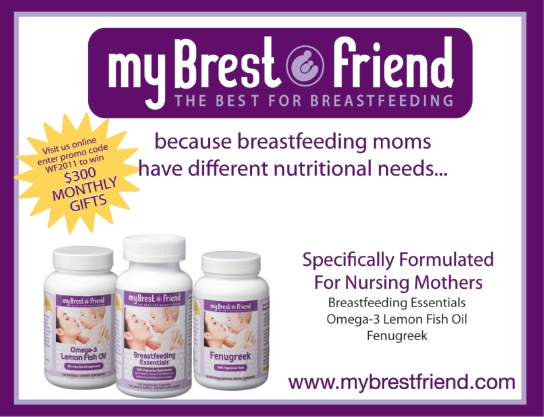 Omegas in proportion. There is growing recognition that the average Western diet is too high in omega-6 fatty acids. This reality may be the reason it is helpful to supplement with omega-3s. “Omega-3 fatty acids, such as EPA and DHA from marine sources, help provide balance in a diet that contains too much omega-6 fatty acid as a result of the change in our food supply and the foods we eat,” says Anderson. He is echoing the widespread notion that, in the case of omega fatty acids and nutrition in general, supplementation is a balancing act for diets that are out of proportion.
Omegas in proportion. There is growing recognition that the average Western diet is too high in omega-6 fatty acids. This reality may be the reason it is helpful to supplement with omega-3s. “Omega-3 fatty acids, such as EPA and DHA from marine sources, help provide balance in a diet that contains too much omega-6 fatty acid as a result of the change in our food supply and the foods we eat,” says Anderson. He is echoing the widespread notion that, in the case of omega fatty acids and nutrition in general, supplementation is a balancing act for diets that are out of proportion.
Anderson provides statistics stating that the contemporary American diet can provide over 20:1 ratios of omega-6 to omega-3s. This is while a ratio of 4:1 is considered ideal. The average American diet can contain more than seven times the proper amount of omega-6, according to Anderson, while obtaining sufficient omega-3s is difficult in a world of processed food. Omega-6 is found in the oils added to most processed foods, while omega-3s, unfortunately, remain somewhat absent. This means retailers can advise customers not just on how much omega-3 fatty acid they need, but what relation that amount should have to the rest of their diets.
Jump-start the heart. A budding view in the cardiovascular health market is that the heart may simply need energy. “Nutritional scientists are now emphasizing that cardiovascular dysfunction often is rooted in a cellular energy deficit, thus spawning interest in nutrients affecting mitochondrial synthesis of energy,” says Shastri.
This bodes well for the prospects of ubiquinol and ubiquinone on the market, as these forms of CoQ10 play an essential role in the electron transport chain’s process of energy synthesis. Sugarek agrees, stating, “CoQ10 is a vitamin-like substance that is present in nearly all human tissues and is essential for the cellular processes of energy production in the mitochondria,” and for this reason has a track record of supporting cardiovascular health.
Under the heading of “metabolic cardiology and myocardial bioenergetics,” the A.C. Grace team also heralds the rise of this same idea. This terminology does not refer to the attention-getting hemodynamic issues (blood pressure) that have always been center stage, but rather to the problem of the energy-starved heart. This condition has been correlated with CHD and heart failure, according to A.C. Grace. Various nutrients, they say, have shown clinical promise toward improving cardiac function, as well as outward symptoms such as fatigue, shortness of breath and angina. These nutrients include carnitine, glutathione, resveratrol, taurine, D ribose and others.
 Resveratrol, in fact, may be a quite versatile nutrient when it comes to heart health. ” Resveratrol indirectly offers heart health support, as it has been studied to help prevent fat production, reduce inflammation and provide endothelial health,” says Maru. The areas he cites can all be counted as influential for cardiovascular function, as detailed in the next section.
Resveratrol, in fact, may be a quite versatile nutrient when it comes to heart health. ” Resveratrol indirectly offers heart health support, as it has been studied to help prevent fat production, reduce inflammation and provide endothelial health,” says Maru. The areas he cites can all be counted as influential for cardiovascular function, as detailed in the next section.
Taking the (In)direct Approach
The majority of the supplements discussed to this point are primarily targeted at the traditional trouble areas within cardiovascular health, namely cholesterol levels, blood pressure and circulation. There are other means, however, some nascent and some well-recognized, of advancing the cause of the heart and its many tributaries. 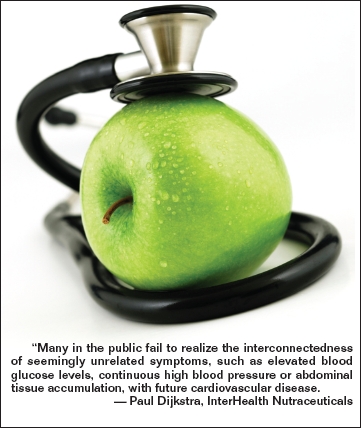
Some of these approaches may save lives, as one expert attests. “While a lot of attention is given to cholesterol, for example, approximately 50% of the people that have a heart attack have normal cholesterol,” says Levy. Also, when dealing with these under-recognized modes of supplementation, it is often up to retailers to clue in their customers. “As with all new ingredients, a certain amount of consumer education is necessary, especially when an ingredient contributes to heart health using a less well-known route,” says Evans.
According to Stuart Tomc, CNHP and national educator for Nordic Naturals, Watsonville, CA, a recent discovery is setting the stage for a major change in views on the relation of inflammation to cardiovascular health. “The biggest changes in the heart heath category are being driven by the acceptance that inflammation may be the root cause of all cardiovascular challenges,” he says.
Prostaglandin E2 (PGE2), which was previously thought to initiate inflammation, is actually being found to perform the opposite task of resolving inflammation. In order to create prostaglandin, which are lipid compounds created from fatty acids, cells have to produce cyclooxygenase-2 (COX-2). This is the COX-2 of COX-2 inhibitor fame. These common drugs are designed to stem the tide of inflammation, but this reversal in understanding suggests they may do the opposite.
 If COX-2 inhibitors are interfering with the mediation and resolution of inflammation, then a different approach to inflammation, an underlying cause of cardiovascular disease, might need to be taken, Tomc explains. Specialized lipid compounds, naturally synthesized from dietary omega-3s and known as resolvins, protectins and maresins, have been found to signal the termination of acute inflammation, moving tissue toward homeostasis and away from a chronic, nonfunctional inflammatory state. “Understanding the inflammatory cascade, the body’s response to it, and how to most effectively mediate its harmful effects is critical in improving cardiovascular health,” Tomc says.
If COX-2 inhibitors are interfering with the mediation and resolution of inflammation, then a different approach to inflammation, an underlying cause of cardiovascular disease, might need to be taken, Tomc explains. Specialized lipid compounds, naturally synthesized from dietary omega-3s and known as resolvins, protectins and maresins, have been found to signal the termination of acute inflammation, moving tissue toward homeostasis and away from a chronic, nonfunctional inflammatory state. “Understanding the inflammatory cascade, the body’s response to it, and how to most effectively mediate its harmful effects is critical in improving cardiovascular health,” Tomc says.
Jonny Bowden, Ph.D., author and member of the nutritional advisory board of Barlean’s, Ferndale, WA, argues that an emphasis on inflammation for heart health is long overdue, and agrees with the suggestion that omega-3s may be part of the answer. “Much is being written on the inflammation connection to heart disease, and I suspect that in the coming decade there will be much more emphasis on omega-3s for their anti-inflammatory (and heart beneficial) effects,” he says.
The connection between diabetes and heart disease is a well-documented, if difficult to face, reality. Fortunately, proactive supplementation could be part of the solution. “Additional heart support could be associated with blood sugar health, since diabetics disproportionately suffer and die from cardiovascular disease,” says Neil Levin, CCN, nutrition education manager for NOW Foods, Bloomingdale, IL. He suggests a laundry list of ingredients that help maintain healthy glucose metabolism, including alpha-lipoic acid, chromium, cinnamon, biotin, Gymnema sylvestre, corosolic acid and others. 
“The biggest issue facing Americans is insulin resistance and its sequelae of weight gain, type 2 diabetes, silent inflammation, metabolic syndrome, etc. The key goal in promoting heart health will be addressing this underlying issue,” says Murray. He suggests that his company’s dietary fiber matrix called PGX can aid insulin sensitivity, stabilize blood sugar levels and help people achieve a healthier body weight. Fiber carries with it an FDA recognized heart health claim that can be applied to food labeling, touting its nutritional support of cardiovascular health.
Blood sugar conditions influence heart health in various ways, according to Kaylor. “Cellular insulin resistance is a profound and primary contributor to several leading cardiovascular indicators, including blood pressure, cholesterol and triglycerides,” he says. Kaylor recommends mushroom remedies like Maitake for increasing insulin sensitivity.
“Media focus on the diabetes epidemic, as well as metabolic syndrome, has raised awareness of those conditions and how they are associated with heart health; that has been reflected in increased sales across the category,” says Paul Dijkstra, CEO of InterHealth Nutraceuticals, Benicia, CA. He claims that weight control and blood sugar management will see increased focus as important cardiovascular health factors.
Unhealthy fat is, by all accounts, a key factor in the onset of CVD and diabetes, which as we just learned is itself a risk factor for CVD. Two of the biggest contributors to metabolic syndrome, explains Sugarek, are visceral fat and excess waistline fat. “This is because fat around the midsection is metabolically active, and when it accumulates, it secretes large quantities of inflammatory compounds within the body, and there is a growing body of evidence that inflammation is the source of a number of chronic conditions, specifically heart disease,” she says. Products that can alter fat metabolism at the genetic level, Sugarek says, will aid in the healthy breakdown and synthesis of fat, which in conjunction with proper diet and exercise will mean less weight accumulation.
 For targeting the visceral fat that forms around organs, there is an ingredient (Viscerol AI from OptiPure) that works by inhibiting the formation of new blood vessels, necessary for growing visceral fat cells. A human clinical study using the ingredient showed that subjects taking 300 mg of the compound three times daily experienced a reduction in visceral fat of 20%, which was more than double that of the placebo group.
For targeting the visceral fat that forms around organs, there is an ingredient (Viscerol AI from OptiPure) that works by inhibiting the formation of new blood vessels, necessary for growing visceral fat cells. A human clinical study using the ingredient showed that subjects taking 300 mg of the compound three times daily experienced a reduction in visceral fat of 20%, which was more than double that of the placebo group.
Dijkstra points out that the problems that diabetes and abdominal fat pose must be recognized before action can be taken. “Many in the public fail to realize the interconnectedness of seemingly unrelated symptoms, such as elevated blood glucose levels, continuous high blood pressure or abdominal tissue accumulation, with future cardiovascular disease. Awareness is the first step in supporting a healthy heart,” he says.
While much of the heart-health focus rightly remains on healthy cholesterol levels, oxidized lipids may be the real culprit, and the market is following this trend. “Many scientists now believe that controlling the oxidation of LDL cholesterol, not just the level of LDL cholesterol, is very important for arterial health,” says Evans. 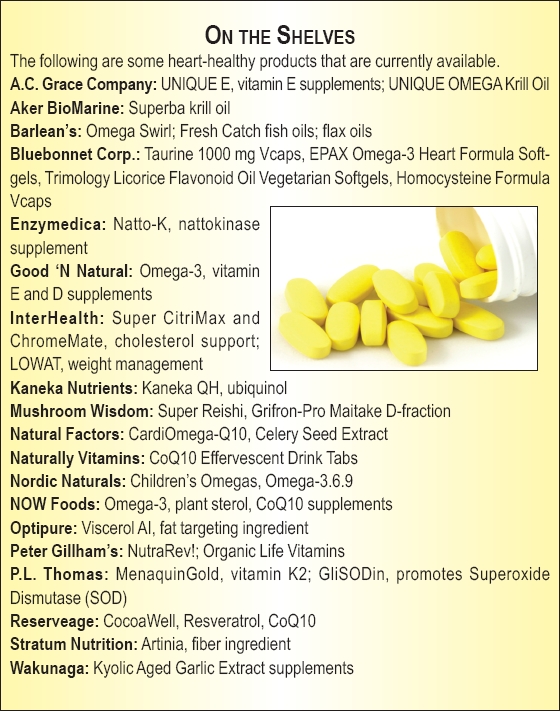
Research indicates that this may be because of inflammatory events in the arteries. These events, which are caused by oxidized cholesterol, leave what are called fatty streaks on artery walls, which in turn can morph into blockage-causing plaque under certain conditions. Stratum’s new patented ingredient (Artinia) is said to reduce the oxidized form of LDL cholesterol, according to Evans.
“One of the developments in formulations has been to counter apolipoprotein-B synthesis, a required structural component of atherogenic lipids including the well-known LDL cholesterol,” says Shastri. Fractions of LDL, and in particular LDL-3, are known for their susceptibility to peroxidation, he explains. It is, generally speaking, the peroxidation of lipids and not their amounts or type that represents the true cardiovascular risk factor.
The amino acid homocysteine has long been viewed as a risk-factor for the development of CVD, but studies have not always shown that decreasing its levels in the bloodstream has heart health benefits. However, this may be due to flaws in the approach of the current research, and further research is underway that may establish a link, according to the American Heart Association (AHA) (7).
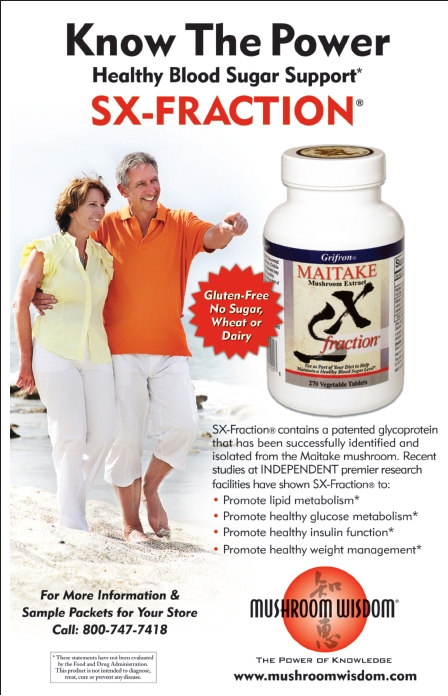 In fact, the AHA recommends the use of B vitamins, namely folic acid, B6 and B12, for those at high risk of heart disease, as these nutrients break down homocysteine in the blood. Sugarek recommends the use of a nutrient formulation that serves this purpose. “It is well known that these three B vitamins in tandem are required to act as cofactors in the homocysteine cycle, and help maintain low levels of homocysteine, thereby supporting optimal heart health,” she says.
In fact, the AHA recommends the use of B vitamins, namely folic acid, B6 and B12, for those at high risk of heart disease, as these nutrients break down homocysteine in the blood. Sugarek recommends the use of a nutrient formulation that serves this purpose. “It is well known that these three B vitamins in tandem are required to act as cofactors in the homocysteine cycle, and help maintain low levels of homocysteine, thereby supporting optimal heart health,” she says.
New Developments: Heart Happenings and Health Claims
From vitamin D upheaval to challenges from outside the supplement industry to new health claims coming down the pipe, there is plenty of hearty discussion, and expert opinion, to peruse below.
The D question. The Institute of Medicine’s (IOM) recent appraisal of vitamin D, and what it can do for you health-wise, caused a cascade of opinion to flood in, with many in the supplements and natural health fields claiming that recommended intakes were not adjusted high enough. But what do insiders say about the vitamin’s relevance for heart health?
“As a nutritionist and advisor to the supplement industry, I would strongly—repeat STRONGLY—suggest no alteration in formulas,” in the direction of reduced dosage, says Bowden. He calls the IOM’s report flawed, citing massive research into the benefits of vitamin D for a wide range of applications, including heart health. Its shortcoming, according to Bowden, was focusing only on the minimum amount required to maintain bone health (the IOM recommended 600 IUs).
Sugarek maintains that vitamin D deficiencies have been linked with heart disease as well as stroke, and explains that supplementation may more strongly benefit some populations. “Vitamin D3 deficiencies are more common in individuals who live in regions where there is restricted sunlight exposure (north of 42 degrees latitude) or a high level of atmospheric pollution, strict vegetarians, dark-skinned people, individuals who constantly wear sunscreen and seniors who primarily stay indoors,” she says.
Others emphasize the vitamin’s link to health issues, regardless of context. “Vitamin D is linked with general heart health, because some recent studies show that individuals with metabolic syndrome have decreased blood levels of vitamin D, even those that live in sunny climates,” says Angelica Vrablic, Ph.D., manager of nutrition research, Good ‘N Natural, Ronkonkoma, NY.
“Vitamin D does have a role in heart health, a benefit that the IOM’s committee that released the new dietary recommendations did not address,” says Levin, who continues, “By contrast, the FDA’s European counterpart EFSA (the European Food Safety Agency) has acknowledged a role for vitamin D in heart health.” This acknowledgement is in the form of language stating that a cause-and-effect relationship between vitamin D and immune health, inflammatory response and muscle function has been established. Since inflammation is a risk factor for CVD, and the heart is most certainly a muscle, Levin argues that the connection is obvious.
While the mildly increased intakes for the vitamin may not have all manufacturers scrambling to increase dosages, formulations are in fact being influenced toward including vitamin D in new products. “In response to recent research linking vitamin D to a number of key roles in optimizing health, and to recommendations that higher intakes are necessary, Nordic Naturals has added vitamin D3 (cholecalciferol) to many of our fish oil products,” says Tomc.
Copycat marketing. The pharmaceutical industry may be planning a coup of the supplement industry’s position on omega-3 products, but manufacturers and retailers should remain undeterred. “I suspect there will be a ton of advertising from the pharmaceutical companies meant to deliver the message that their proprietary, patented omega-3 fish oil prescription ‘medicines’ are preferable to the ‘unregulated’ supplements of omega-3,” says Bowden. The first to market of these omega-3 derived prescription medications, called Lovaza, had nearly $1 billion in sales last year.
"We should be concentrating on getting out the message that this is nonsense,” continues Bowden. “High-quality fish oil like Barlean’s is absolutely equal to the prescription-only fish oil formulas being developed by the pharmaceutical companies, and is cheaper to boot,” he concludes. Rival medications to Lovaza are yet to arrive, but some analysts think that all omega-3 products, natural and prescription alike, will inevitably be duking it out for public attention.
Many believe that, in any event, there will be minimal overlap between the two industries, because of factors like price difference and the differing applications of 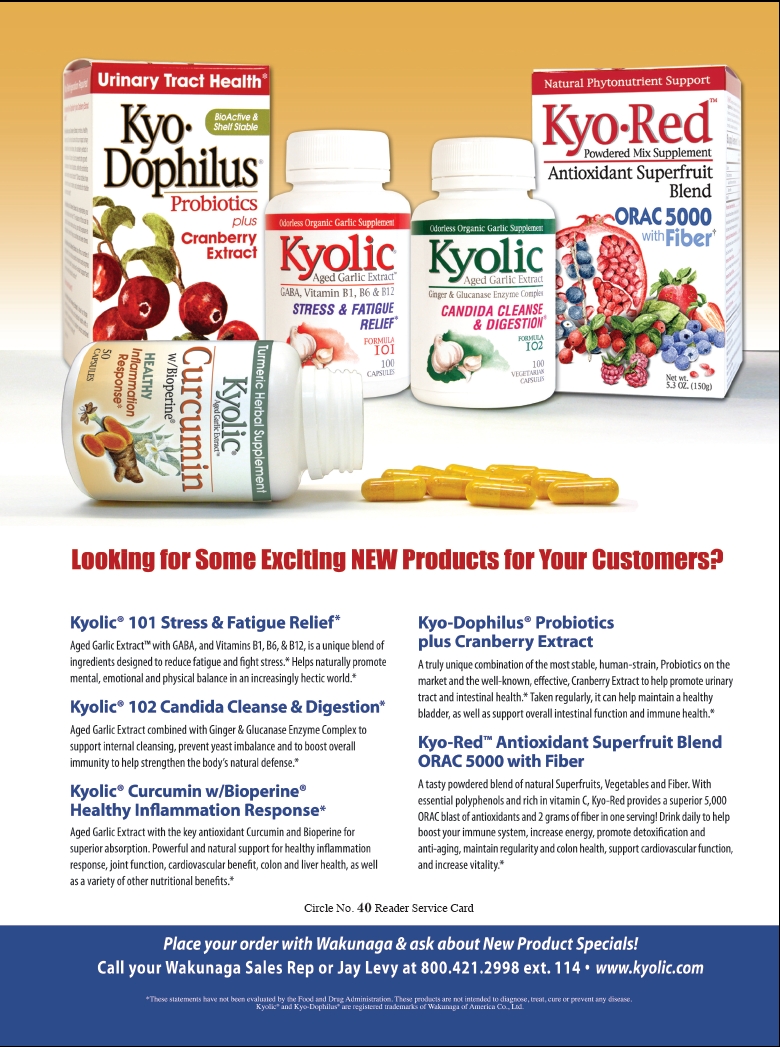 prescription and supplement forms. In addition, supplements grant the option of fortification with other nutrients, such as the popular omega-3 and antioxidant combination products on the market. So, sales of omega-3 supplements should not be disturbed by the encroachment of the prescription option.
prescription and supplement forms. In addition, supplements grant the option of fortification with other nutrients, such as the popular omega-3 and antioxidant combination products on the market. So, sales of omega-3 supplements should not be disturbed by the encroachment of the prescription option.
While demanding respect for the industry’s products is laudable, in other respects, some feel we must be wary of how close supplement makers might become to big pharmaceutical companies. Whitman cautions the natural products industry of following the lead of pharmaceutical marketing. “There is a tendency in the supplement industry to also put the latest lab creations in the spotlight. But it’s not necessarily something new that will solve some of our key health problems,” he says. Instead, Whitman thinks it may be the overlooked basics of nutrition and lifestyle that offer the greatest benefits.
Marketing claims. Vitamin K2 supplier NattoPharma is confident in the heart health applications of its patented form of the vitamin, and an EFSA-approved cardiovascular health claim may not be too far off. The status of FDA-approved heart health claims, with various degrees of qualified language, is a constant subject of discussion in the industry. There is some consensus that it all started with one claim. “I think that the qualified health claim for omega-3 fatty acids set the standard for what to expect from FDA and has certainly enabled the category to grow exponentially,” says Vrablic.
Other related claims are well-known as well, including language approved in connection with: B vitamins and vascular disease, soluble fiber and risk of CHD, soy protein and CHD and plant sterols and CHD to name a few. One promising development is for the plant sterol claim, which FDA announced late last year. FDA may amend the regulation to allow more foods to be labeled with the claim, allow more types of phytosterols to qualify for the claim, and to adjust the intake levels recommended for health benefits. In terms of new claims, one development may involve tocotrienols (the vitamin E compontent). According to A.C. Grace, their brand has received GRAS (Generally Regarded As Safe) status and the industry as a whole will likely pursue a health claim in the future.
Outside the FDA-approved realm things get dicier. When companies make unapproved heart health claims on supplement labels, especially concerning cholesterol, they do so at their own risk. “Claims are limited to ‘supports a healthy heart’ or ‘supports normal cholesterol levels already in the normal range,’ which may not be eye-catching to consumers. However, heart health products come under increased scrutiny with stronger claims than these,” says Dijkstra.
“Since cholesterol is technically a structure of the body, the Dietary Supplements Health and Education Act DSHEA should allow for this type of information sharing, but the regulatory agencies have deemed this a disease claim. As usual, the powers that be appear set on obstructing most statements or claims of benefit even when they fit within the legal guidelines,” says Kaylor, who argues that this is a barrier to consumer education.
These limitations should not be an obstacle for a good product, experts say. “Heart-health supplement buyers are sophisticated and informed, and we believe excess claims should be avoided. Sales are not dependent on structure/function claims; published science is at the foundation of a successful product,” says Shastri. In any event, Levin believes things may soon change to allow less restricted labeling claims, saying, “The Jonathon Emord victories in the area of qualified health claims mean that hopefully we will soon be able to make stronger label claims regarding the role of certain nutrients to support health.”
Supplements and Lifestyle
As will be apparent by now, supplement makers agree that no one solution is the be-all-end-all for the cardiovascular health category. The other thing they all agree on is that lifestyle choices round out the equation for a healthy heart. “Because supplementation is just one of the ways to achieve optimal heart health, we regularly provide information on how a heart-healthy diet, exercise and other heart-healthy lifestyle choices contribute to better cardiovascular health,” says Levy, who adds that his company accomplishes this through booklets, magazine articles, web content, ad campaigns and social media.
Whitman cites his company’s magazine, Organic Connections and its Web site devoted to the health of children, www.naturalvitalitykids.com, as examples of emphasizing the holistic approach to health. Efforts like these are part and parcel of guiding consumers toward healthier living for the sake of their hearts. Levin says, “While we are certainly focused on the ability of our products to contribute benefits in these areas, we are never unmindful of its properly limited, but important role in a healthy person.” WF
References
1. J. M. Geleijnse, et al., “Dietary Intake of Menaquinone Is Associated with a Reduced Risk of Coronary Heart Disease: The Rotterdam Study,” The Journal of Nutrition 134 (11), 3100-3105 (2004).
2. J. Y. Kim, et al., “Effects of Nattokinase on Blood Pressure: A Randomized, Controlled Trial,” Hypertension Research 31, 1583–1588 (2008).
3. “Research Topics,” Nutritional Magnesium Association,http://www.nutritionalmagnesium.org/research/9.html, accessed Dec. 28, 2010.
4. “Aged Garlic Extract: Useful Adjunct Therapy for Hypertension Patients,” WholeFoods Magazine, https://wholefoodsmagazine.com/news/research/aged-garlic-extract-useful-adjunct-therapy-hypertension-patients, accessed Jan. 4, 2011.
5. S. Singh, et al., “Evaluation of anti-inflammatory activity of plant lipids containing alpha-linolenic acid,” Indian J. Exp. Biol. 46(6), 453-6 (2008).
6. M. Berbée, et al., “Gamma-Tocotrienol ameliorates intestinal radiation injury and reduces vascular oxidative stress after total-body irradiation by an HMG-CoA reductase-dependent mechanism,” Radiat. Res. 171, 596-605 (2009).
7. “What is Homocysteine?” American Heart Association, http://www.americanheart.org/
presenter.jhtml?identifier=535, accessed Dec. 29, 2010.
Published in WholeFoods Magazine, February 2011

